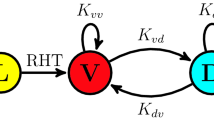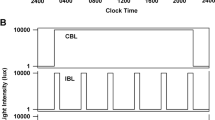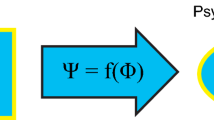Abstract
SINCE the first report in unicells1, studies across diverse species have demonstrated that light is a powerful synchronizer which resets, in an intensity-dependent manner, endogenous circadian pacemakers1–5. Although it is recognized that bright light (∼7,000 to 13,000 lux) is an effective circadian synchronizer in humans6–10, it is widely believed that the human circadian pacemaker is insensitive to ordinary indoor illumination (∼50–3001ux)11. It has been proposed that the relationship between the resetting effect of light and its intensity follows a compressive nonlinear function12, such that exposure to lower illuminances still exerts a robust effect13. We therefore undertook a series of experiments which support this hypothesis and report here that light of even relatively low intensity (∼180 lux) significantly phase-shifts the human circadian pacemaker. Our results clearly demonstrate that humans are much more sensitive to light than initially suspected and support the conclusion that they are not qualitatively different from other mammals in their mechanism of circadian entrainment14.
This is a preview of subscription content, access via your institution
Access options
Subscribe to this journal
Receive 51 print issues and online access
$199.00 per year
only $3.90 per issue
Buy this article
- Purchase on Springer Link
- Instant access to full article PDF
Prices may be subject to local taxes which are calculated during checkout
Similar content being viewed by others
References
Hastings, J. W. & Sweeney, B. M. Biol. Bull. 115, 440–458 (1958).
Chandrashekaran, M. K. & Loher, W. J. exp. Zool. 172, 147–152 (1969).
McGuire, R. A., Rand, W. M. & Wurtman, R. J. Science 181, 956–957 (1973).
Takahashi, J. S., DeCoursey, P. J., Bauman, L. & Menaker, M. Nature 308, 186–188 (1984).
Nelson, D. E. & Takahashi, J. S. J. Physiol. (Lond.) 439, 115–145 (1991).
Van Cauter, E. et al. Am. J. Physiol. 266, E953–E963 (1994).
Czeisler, C. A. Circadian Clocks and their Adjustment. Chichester (Ciba Foundation Symp. 183) 254–302 (Wiley, 1995).
Czeisler, C. A. et al. Science 244, 1328–1333 (1989).
Minors, D. S., Waterhouse, J. M. & Wirz-Justice, A. Neurosci. Lett. 133, 36–40 (1991).
Honma, K. & Honma, S. Jap. J. Psych. Neurol. 42, 167–168 (1988).
Wever, R. A. J. biol. Rhythms 4, 161–185 (1989).
Kronauer, R. E. Sleep Res. (abstract) 16, 621 (1987).
Klerman, E. B., Dijk, D.-J., Kronauer, R. E. & Czeisler, C. A. Am. J. Physiol. 39, R271–R282 (1996).
Czeisler, C. A., Richardson, G. S., Zimmerman, J. C., Moore-Ede, M. C. & Weitzman, E. D. Photochem. Photobiol. 34, 239–247 (1981).
Boivin, D. B., Duffy, J. F., Kronauer, R. E. & Czeisler, C. A. J. biol. Rhythms 9, 315–331 (1994).
Kronauer, R. E., Duffy, J. F. & Czeisler, C. A. Sleep Res. 22, 626 (1993).
Jewett, M. E., Kronauer, R. E. & Czeisler, C. A. J. biol. Rhythms 9, 295–314 (1994).
Allan, J. S., Czeisler, C. A., Duffy, J. F. & Kronauer, R. E. 154th Ann. A.A.A.S. Meeting 208, 101 (1988).
Campbell, S. S., Dawson, D. & Zulley, J. Sleep 16, 638–640 (1993).
Czeisler, C. A. et al. Sleep Res. (abstract) 24, 505 (1995).
Winfree, A. T. J. theor. Biol. 28, 327–374 (1970).
Kronauer, R. E., Jewett, M. E. & Czeisler, C. A. J. biol. Rhythms 8, 351–360 (1993).
Gaddy, J. R., Rollag, M. D. & Brainard, G. C. J. clin. Endocrin. Metab. 77, 1398–1401 (1993).
Bojkowski, C. J. et al. Horm. Metabol. Res. 19, 437–440 (1987).
Mclntyre, I. M., Norman, T. R., Burrows, G. D. & Armstrong, S. M. J. pineal Res. 6, 149–156 (1989).
Laakso, M., Hätönen, T., Stenberg, D., Alila, A. & Smith, S. J. Pineal Res. 15, 21–26 (1993).
Wehr, T. A., Giesen, H. A., Moul, D. E., Turner, E. H. & Schwartz, P. J. Am J. Physiol. 269, 173–178 (1995).
Honma, K.-I. et al. Am. J. Physiol. 268, R528–R535 (1995).
Jewett, M. E., Kronauer, R. E. & Czeisler, C. A. Nature 350, 59–62 (1991).
Cole, R. J. et al. J. biol. Rhythms 10, 324–334 (1995).
Czeisler, C. A. et al. Science 233, 667–671 (1986).
Brown, E. N. & Czeisler, C. A. J. biol. Rhythms 7, 177–202 (1992).
Author information
Authors and Affiliations
Rights and permissions
About this article
Cite this article
Boivin, D., Duffy, J., Kronauer, R. et al. Dose-response relationships for resetting of human circadian clock by light. Nature 379, 540–542 (1996). https://doi.org/10.1038/379540a0
Received:
Accepted:
Issue Date:
DOI: https://doi.org/10.1038/379540a0
This article is cited by
-
InP colloidal quantum dots for visible and near-infrared photonics
Nature Reviews Materials (2023)
-
Sleep alteration in the van der Pol-type circadian pacemaker model driven by natural light and intermittent noise
Nonlinear Dynamics (2023)
-
Development of the circadian system in early life: maternal and environmental factors
Journal of Physiological Anthropology (2022)
-
Circadian lipid and hepatic protein rhythms shift with a phase response curve different than melatonin
Nature Communications (2022)
-
Diurnal rhythms of urine volume and electrolyte excretion in healthy young men under differing intensities of daytime light exposure
Scientific Reports (2021)
Comments
By submitting a comment you agree to abide by our Terms and Community Guidelines. If you find something abusive or that does not comply with our terms or guidelines please flag it as inappropriate.



